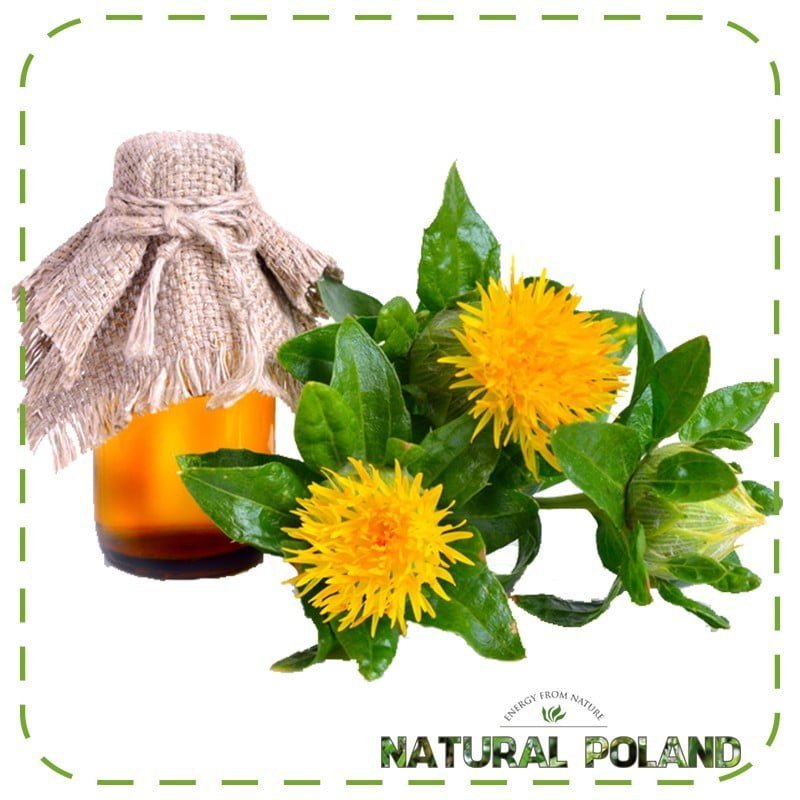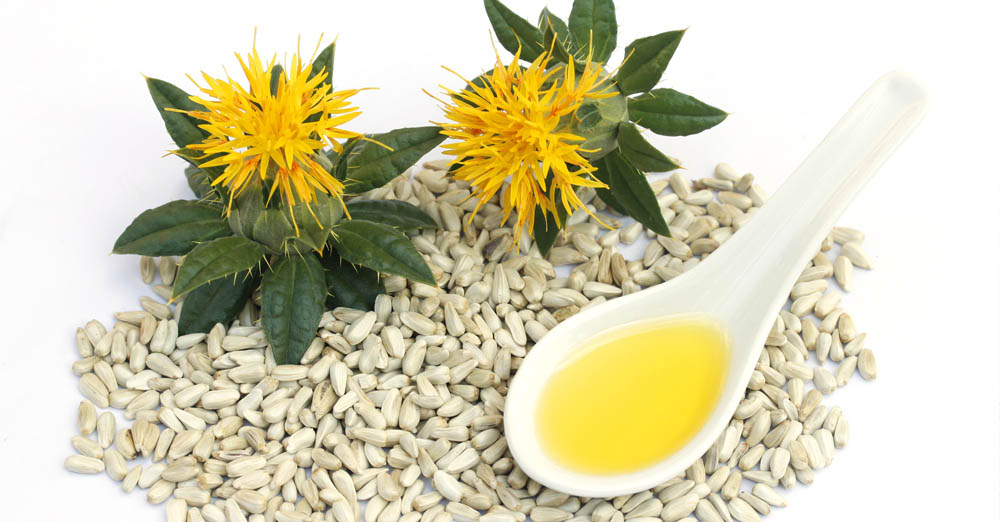Safflower oil is derived from cold-pressed seeds of the plant safflower. It has an intensive golden-yellow color. The product is rich particularly in vitamins A and E, as well as has high contents of valuable fatty acids, such as linoleic, lanolin, oleic, stearic and arachidonic acids, which are necessary for the proper functioning of the body, especially the skin. It is recommended by physicians due to its favorable properties for the heart. Moreover, it is a tasty and healthy cooking ingredient.
What is safflower?
Safflower is also known as false saffron or dyer’s saffron. It was known as early as in ancient Greece, however, widespread cultivation in Europe started only in the 18th century. It is a plant of the Asteraceae family, originating from the Middle East and India, highly valued in the Iranian culture. For centuries, safflower has been used to dye textiles, foodstuffs and cosmetics. The seeds of the plant are used to obtain oil.
It is cold-pressed and considered a very rich source of valuable polyunsaturated fatty acids and nutritional components, including:
- linoleic acid,
- linolenic acid,
- oleic acid,
- stearic acid
- arachidonic acid,
- plant sterols,
- luteolin,
- vitamin A,
- vitamin E.

Safflower oil
Safflower seed oil is extremely rich in omega-6 fatty acids.
Uses of safflower oil
Regular consumption of safflower oil:
- lowers the level of bad cholesterol,
- effectively prevents arteriosclerosis, cerebral stroke or myocardial infarction, as well as lowers blood pressure and decreases the risk of thromboembolism,
- regulates blood glucose, as the oil has antidiabetic properties,
- helps eliminate secretion in the bronchi thanks to its expectorant properties, which reduces chest congestion and breathing difficulties as well as supports the treatment of upper respiratory track infections,
- lowers body temperature,
- regulates bowel movements and prevents constipation,
- mitigates unpleasant menopausal symptoms as well as reduces menstrual pain,
- helps maintain proper body weight by stimulating fat cell metabolism and accelerated fat tissue burning.
Safflower oil in cosmetics
Safflower oil is highly valued as a cosmetic ingredient as well. Its application is recommended particularly in haircare, as it stimulates hair growth, prevents hair loss and regenerates damaged and dry hair.
Furthermore, the oil:
- stimulates skin regeneration,
- halts skin inflammation, accelerates healing of wounds, acne and psoriasis,
- reduces wrinkles and makes the skin supple and properly moisturized,
- neutralizes free radicals,
- lowers the skin’s photo-sensitivity that may result in burns,
- is also considered as a natural epilator, as it may contribute to reduction of body hair (although this property has not been fully confirmed, yet).
How to use safflower oil?
It is recommended to consume approximately 15 ml of safflower oil twice a day. It may be consumed on its own or used in dishes. It is a perfect base of home-made mayonnaise and ingredient in preparation of various salads, as thanks to its delicate flavor it does not interfere with the actual taste of the dish.
By making safflower oil a part of your regular diet, you can prevent the development of many inflammatory conditions; it is just after a few weeks that the body increases its immunity significantly and is able to keep inflammation off.
Given that safflower oil is cold-pressed, it should not be used for frying or cooking. It should only be used cold, and should never be heated above 65 degrees Celsius.
Who can benefit the most from safflower oil?
Thanks to its properties and composition, safflower oil is particularly beneficial for:
- women suffering from menstrual pain and in menopause,
- persons with high blood cholesterol,
- diabetics,
- persons with elevated blood pressure,
- to prevent cardiovascular system diseases,
- in colds, against high temperature and cough,
- persons suffering from recurring constipation,
- persons interested in healthy skin and hair.
Safflower oil should not be used by pregnant women, as large amounts of this plant may lead to miscarriage. Similarly, safflower should be avoided by breast-feeding women.
BIBLIOGRAPHY
- Porównawcze badania wpływu nasion wiesiołka i krokosza barwierskiego na wybrane parametry morfologiczne i biochemiczne krwi szczurów doświadczalnych z dietą bogatotłuszczową E, Wincewicz, W.Zawadzki, M.Ostaszewska
- http://www.medycynawet.edu.pl/images/stories/pdf/pdf2015/062015/201506377381.pdf Roślinne surowce lecznicze – badania makroskopowo – mikroskopowe, Skrypt do ćwiczeń z farmakognozji pod redakcją prof. dr hab. n. farm. Jana Gudeja.
- Medical uses of Carthamus tinctorius L. (Safflower): a comprehensive review from Traditional Medicine to Modern Medicine; Elahe Delshad, Mahdi Yousefi, Payam Sasannezhad, Hasan Rakhshandeh and Zahra Ayati.
- William Charles Evans BPharm BSc PhD DSc FIBiol FLS FRPharmS, Daphne Evans BA MA, in Trease and Evans’ Pharmacognosy (Sixteenth Edition), 2009.


